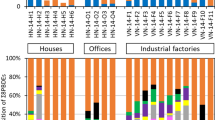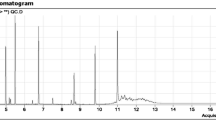Abstract
Bisphenol A (BPA) is used in the production of polycarbonate plastics and epoxy resins, which are used in many consumer products. Sources of human exposures to BPA include packaged and canned food products, indoor air, and dust ingestion. Information on the relative contributions of the pathways to BPA exposures is limited. In this study, we measured concentrations BPA in indoor dust collected from two locations in the Eastern United States and evaluated the contribution of dust to total BPA exposures. BPA was found in 95% of the dust samples analyzed (n = 56) at concentrations ranging from <0.5 to 10,200 ng/g (mean 843; median 422). The median values for BPA intake by way of the ingestion of dust by adults and toddlers were calculated to be 0.35 and 5.63 ng/kg body weight/day. These estimated exposure doses of BPA through dust ingestion are of the same order of magnitude as the recently reported low concentrations that induced health effects in laboratory animal studies. The contribution of dust to total human BPA intake was estimated to be <1%, however, suggesting that dietary intake is the predominant source of exposures in humans.
Similar content being viewed by others
References
Ballesteros-Gomez A, Rubio S, Perez-Bendito D (2009) Analytical methods for the determination of bisphenol A in food. J Chromatogr A 1216:449–469
Braun JM, Yolton K, Dietrich KN, Hornung R, Ye X, Calafat AM et al (2009) Prenatal bisphenol A exposure and early childhood behavior. Environ Health Perspect 117:1945–1952
Calafat AM, Ye XY, Wong LY, Reidy JA, Needham LL (2008) Exposure of the US population to bisphenol A and 4-tertiary-octylphenol: 2003–2004. Environ Health Perspect 116:39–44
Cao XL, Corriveau J, Popovic S (2009) Migration of bisphenol A from can coatings to liquid infant formula during storage at room temperature. J Food Protect 72:1472–1475
Carwile JL, Luu HT, Bassett LS, Driscoll DA, Yuan C, Chang JY et al (2009) Polycarbonate bottle use and urinary bisphenol A concentrations. Environ Health Perspect 117:1368–1372
Dekant W, Völkel W (2008) Human exposure to bisphenol A by biomonitoring: methods, results and assessment of environmental exposures. Toxicol Appl Pharmacol 228:114–134
EC - European Commission (2002) Opinion of the Scientific Committee on Food on Bisphenol A. SCF/CS/PM/3936 Final. Scientific Committee on Food, Brussels
EFSA - European Food Safety Authority (2006) Opinion of the Scientific Panel on food additives, flavourings, processing aids, and materials in contact with food on a request from the commission related to bisphenol A question number EFSA-Q-2005–100. EFSA J 428:1–75
FAO/WHO (2010) Joint FAO/WHO Expert Meeting to Review Toxicological and Health Aspects of Bisphenol A. http://www.who.int/foodsafety/chem/chemicals/BPA_Summary2010.pdf. Accessed 25 Nov 2010
Fu P, Kawamura K (2010) Ubiquity of bisphenol A in the atmosphere. Environ Pollut 158:3138–3143
Geens T, Roosens L, Neels H, Covaci A (2009) Assessment of human exposure to bisphenol-A, triclosan and tetrabromobisphenol-A through indoor dust intake in Belgium. Chemosphere 76:755–760
Groff T (2010) Bisphenol A: invisible pollution. Curr Opin Pediatr 22:524–529
Inoue K, Yamaguchi A, Wada M, Yoshimura Y, Makino T, Nakazawa H (2001) Quantitative detection of bisphenol A and bisphenol A diglycidyl ether metabolites in human plasma by liquid chromatography–electrospray mass spectrometry. J Chromatogr B 765:121–126
Inoue K, Kawaguchi M, Funakoshi Y, Nakazawa Y (2003) Size exclusion flow extraction of bisphenol A in human urine for liquid chromatography–mass spectrometry. J Chromatogr B 798:17–23
IRIS (2002) United States Environmental Protection Agency-Integrated Risk Information System: bisphenol A (CASRN 80-05-7). http://www.epa.gov/iris/subst/0356.htm. Accessed 25 Dec 2010
Johnson-Restrepo B, Kannan K (2009) An assessment of sources and pathways of human exposure to polybrominated diphenyl ethers in the United States. Chemosphere 76:542–548
Jones-Otazo HA, Clarke JP, Diamond ML, Archbold JA, Ferguson G, Harner T et al (2005) Is house dust the missing exposure pathway for PBDEs? An analysis of the urban fate and human exposure to PBDEs. Environ Sci Technol 39:5121–5130
Kang J-H, Kondo F, Katayama Y (2006) Human exposure to bisphenol A. Toxicology 226:79–89
Kannan K, Takahashi S, Fujiwara N, Mizukawa H, Tanabe S (2010) Organotin compounds, including butyltins and octyltins, in house dust from Albany, New York, USA. Arch Environ Contam Toxicol 58:901–907
Lang IA, Galloway TS, Scarlett A, Henley WE, Depledge M, Wallace RB et al (2008) Association of urinary bisphenol A concentrations with medical disorders and laboratory abnormalities in adults. JAMA 300:1303–1310
Lim DS, Kwack SJ, Kim KB, Kim HS, Lee BM (2009) Risk assessment of bisphenol A migrated from canned foods in Korea. J Toxicol Environ Health A 72:1327–1335
Mariscal-Arcas M, Rivas A, Granada A, Monteagudo C, Murcia MA, Olea-Serrano F (2009) Dietary exposure assessment of pregnant women to bisphenol-A from cans and microwave containers in Southern Spain. Food Chem Toxicol 47:506–510
Markham DA, Waechter JM, Wimber M, Rao N, Connolly P, Chuang JC et al (2010) Development of a method for the determination of bisphenol A at trace concentrations in human blood and urine and elucidation of factors influencing method accuracy and sensitivity. J Anal Toxicol 34:293–303
Matsumoto A, Kunugita N, Kitagawa K, Isse T, Oyama T, Foureman GL et al (2003) Bisphenol A levels in human urine. Environ Health Perspect 111:101–104
Matsumoto H, Adachi S, Suzuki Y (2005) Bisphenol A in ambient air particulates responsible for the proliferation of MCF-7 human breast cancer cells and its concentration changes over 6 months. Arch Environ Contam Toxicol 48:459–466
Meeker JD, Calafat AM, Hauser R (2010) Urinary bisphenol A concentrations in relation to serum thyroid and reproductive hormone levels in men from an infertility clinic. Environ Sci Technol 44:1458–1463
Melzer D, Rice NE, Lewis C, Henley WE, Galloway TS (2010) Association of urinary bisphenol A concentration with heart disease: evidence from NHANES 2003/06. PLoS One 5(1):e8673. doi:10.1371/journal.pone.0008673
NTP National Toxicology Program (2008) The potential human reproductive and developmental effects of bisphenol A. NIH publication No. 08-5994. Available at: http://cerhr.niehs.nih.gov/evals/bisphenol/bisphenol.pdf. Accessed: 10 Aug 2010
Padmanabhan V, Siefert K, Ransom S, Johnson T, Pinkerton J, Anderson L et al (2008) Maternal bisphenol-A levels at delivery: a looming problem? J Perinatol 28:258–263
Ritcher CA, Birnbaum LS, Farabollini F, Newbold RR, Rubin BS, Talsness CE et al (2007) In vivo effects of bisphenol A in laboratory rodent studies. Reprod Toxicol 24:199–224
Roberts JW, Wallace LA, Camann DP, Dickey P, Gilbert SG, Lewis RG et al (2009) Monitoring and reducing exposure of infants to pollutants in house dust. Rev Environ Contam Toxicol 201:1–39
Rudel RA, Perovich LJ (2009) Endocrine disrupting chemicals in indoor and outdoor air. Atm Environ 43:171–180
Rudel RA, Brody JG, Spengler JD, Vallarino J, Geno PW, Sun G et al (2001) Identification of selected hormonally active agents and animal mammary carcinogenesis in commercial and residential air and dust samples. J Air Waste Manage Assoc 51:499–513
Rudel RA, Camann DE, Spengler JD, Korn LR, Brody JG (2003) Phthalates, alkylphenols, pesticides, polybrominated diphenyl ethers, and other endocrine-disrupting compounds in indoor air and dust. Environ Sci Technol 37:4543–4555
Staples CA, Dorn PB, Klecka GM, O’Block ST, Harris LR (1998) A review of the environmental fate, effects, and exposures of bisphenol A. Chemosphere 36:2149–2173
Thomson BM, Grounds PR (2005) Bisphenol A in canned foods in New Zealand: an exposure assessment. Food Addit Contam 22:65–72
USEPA (2008) Child-specific exposure factors handbook, EPA/600/R-06/096F, Sep 2008, http://www.epa.gov/ncea, National Center for Environmental Assessment, Office of Research and Development, Washington, DC
Vandenberg LN, Hauser R, Marcus M, Olea N, Welshons WV (2007) Human exposure to bisphenol A (BPA). Reprod Toxicol 24:139–177
Vandenberg LN, Maffini MV, Sonnenschein C, Rubin BS, Soto AM (2009) Bisphenol-A and the great divide: a review of controversies in the field of endocrine disruption. Endocrine Rev 30:75–95
Völkel W, Kiranoglu M, Frommeos H (2008) Determination of free and total bisphenol A in human urine to assess daily uptake as a basis for a valid risk assessment. Toxicol Lett 179:155–162
vom Saal FS, Cooke PS, Buchanan DL, Palanza P, Thayer KA, Nagel SC et al (1998) A physiologically based approach to the study of bisphenol A and other estrogenic chemicals on the size of reproductive organs, daily sperm production, and behavior. Toxicol Ind Health 14:239–260
von Goetz N, Wormuth M, Scheringer M, Hungerbühler K (2010) Bisphenol A: how the most relevant exposure sources contribute to total consumer exposure. Risk Anal 30:473–487
Welshons WV, Nagel SC, vom Saal FS (2006) Large effects from small exposures III. Endocrine mechanisms mediating effects of bisphenol A at levels of human exposure. Endocrinology 147:S56–S69
Wilson NK, Chuang JC, Lyu C (2001) Levels of persistent organic pollutants in several child daycare centers. J Expo Anal Environ Epidemiol 11:449–458
Wilson NK, Chuang JC, Morgan MK, Lordo RA, Sheldon LS (2007) An observational study of the potential exposures of preschool children to pentachlorophenol, bisphenol-A, and nonylphenol at home and daycare. Environ Res 103:9–20
Yang M, Kim SY, Lee SM, Chang SS, Kawamoto T, Jang JY et al (2003) Biological monitoring of bisphenol A in a Korean population. Arch Environ Contam Toxicol 44:546–551
Acknowledgments
We thank Murray State University Facilities Management Services for providing samples and Drs. Bommanna G. Loganathan (Murray State University, Murray, KY), Chunyang Liao, Mr. Se Hun Yun, and Qian Wu (Wadsworth Center, Albany, NY) for technical assistance during the analysis.
Author information
Authors and Affiliations
Corresponding author
Rights and permissions
About this article
Cite this article
Loganathan, S.N., Kannan, K. Occurrence of Bisphenol A in Indoor Dust from Two Locations in the Eastern United States and Implications for Human Exposures. Arch Environ Contam Toxicol 61, 68–73 (2011). https://doi.org/10.1007/s00244-010-9634-y
Received:
Accepted:
Published:
Issue Date:
DOI: https://doi.org/10.1007/s00244-010-9634-y




